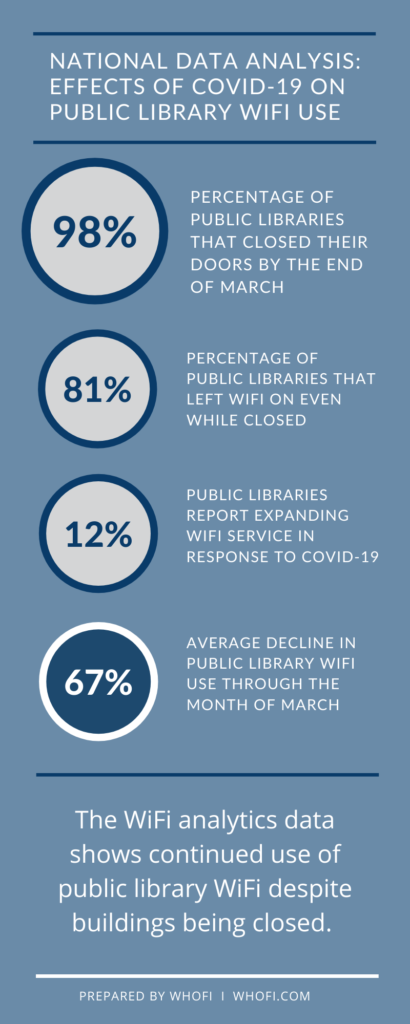Effects of COVID-19 on Public Library WiFi Use
Public libraries adapt to the needs of their local communities. This has proven to be true in the COVID-19 pandemic. We analyzed data from our library partners to understand the effects of COVID-19 on public library WiFi use. While 98% of public libraries closed their doors to the public by the end of March, libraries quickly adapted to continue service. These changes came in many forms, one of which is the continuation of free WiFi service. This report takes a detailed look at WiFi usage during March as libraries closed and patron behavior changed.
98% of public libraries close to the public. 81% keep their WiFi available to the public.
WhoFi is a service provider for a technology called WiFi analytics, which is how we gathered the data presented in this report. WiFi Analytics shows big picture trends in WiFi usage such as changes in the number of users, busy times of day, and new vs. return rates. This service provides insights to guide data influenced decisions for things like strategic planning, day to day operations, advocacy communications, and programming enhancements while maintaining patron privacy. The data shows our library partner’s things they wouldn’t have realized otherwise.
WiFi analytics is showing the continued use of library public WiFi despite the closure.

A library closure could be devastating for the individuals and communities that rely on them for all kinds of services. As we well know, libraries do more than check out paper books. Instead of adopting a closed-door, closed services mentality, libraries are quickly adapting. In-person services are created for an online platform, library cards are being issued online, digital learning and check-out programs are being expanded, and free WiFi services continue and grow even more robust. In typical library fashion, they rise to meet the needs of the community they serve quickly, efficiently, and compassionately.
Since mid-March, we’ve heard mutterings and seen stories of libraries adopting the above practices, specifically extending WiFi services. More than simply leaving the WiFi on, libraries are making it easier to access and creating ‘drive-in WiFi’ hotspots to help patrons. If there’s ever a time we need internet access, it’s now. Schools are adopting online learning platforms, many jobs are being done remotely, grocery shopping is done online, and millions of Americans are newly unemployed and need to be able to apply for benefits, find work and seek care. These are all difficult tasks without the internet, perhaps even unsafe in these current conditions.
Libraries can use data to assess patron behavior amid COVID-19 and determine how to best help them.
Our mission is to help community organizations grow by providing accurate insights so they can better serve their community. We consolidated data from our library partners across the U.S. to gain a better understanding of the national response to the COVID-19 outbreak. The following blog posts will outline trends in patron behavior in response to the pandemic and other important factors. If you have questions about your library, please contact our customer support team, and if you’d like to learn more about implementing WiFi analytics at your library, schedule a demo with our team.
1. According to data from the PLA Survey and Response to COVID-19.
2. According to WhoFi data on file for 25 library partners across the U.S.
